MFs debt schemes: Sebi asks to make disclosure based on interest, credit risk
In this regard, a display table has been made mandatory from December 1, 2021, Sebi said

New Delhi: Markets regulator Sebi on Monday asked mutual funds to classify all debt schemes in terms of a potential risk class matrix, based on interest and credit risk.
In this regard, a display table has been made mandatory from December 1, 2021, the Securities and Exchange Board of India (Sebi) said in a circular.
The 9-cell table or matrix will display the interest and credit risk associated with the scheme. This will provide relevant information to investors to make an informed decision while making decision low risk to moderate risk to high risk in combination of credit and interest rate risks, Samco Securities, Head RankMF, Omkeshwar Singh, said.
While the Risk-o-Meter reflects the current risk of the scheme at a given point in time, Sebi said a need was felt for disclosure of the maximum risk the fund manager can take in the scheme.
“It has been decided that all debt schemes also be classified in terms of a Potential Risk Class matrix consisting of parameters based on maximum interest rate risk (measured by Macaulay Duration (MD) of the scheme) and maximum credit risk (measured by Credit Risk Value (CRV) of the scheme),” Sebi said.
The decision has been taken based on the recommendation of the Mutual Fund Advisory Committee (MFAC) and discussions held with the mutual fund industry.
Sebi said asset management companies (AMCs) will have full flexibility to place single or multiple schemes in any cell of the Potential Risk Class matrix (PRC).
For the purpose of alignment of the existing schemes with the provisions of the new framework, each scheme will be placed in one of the 9 cells specified by the regulator, while retaining their existing scheme category as specified under ‘Categorization and Rationalization of Mutual Fund Schemes’. This would not be considered as a change in fundamental attribute.
However, subsequently, once a PRC cell selection is done by the scheme, any change in the positioning of the scheme into a cell resulting in a risk (in terms of credit risk or duration risk) which is higher than the maximum risk specified for the chosen PRC cell, will be considered as a fundamental attribute change of the scheme.
Further, the mutual funds will have to inform the unitholders about the classification in one of the 9 cells and subsequent changes, if any, through SMS and by providing a link on their website referring to the change.
For new debt schemes, the AMC will have choose the PRC cell at the time of filing of Scheme Information document (SID) with Sebi.
Fresh investments in perpetual bonds (including Additional Tier 1 bonds) can only be made in schemes that are in Class III.
For instruments with an interest rate reset dates, the interest rate reset date will not be treated as deemed maturity.
The dynamic aspect of the risk of each scheme would be separately reflected in the Risk-o-Meter of the scheme, which would be published on a monthly basis.
Mutual Funds will have to publish the matrix in their scheme-wise annual reports and abridged summary.
With regards to disclosure, Sebi said the matrix along with the mark for the cell in which the scheme resides need to be disclosed on the front page of the initial offering application form, Scheme Information Documents (SID), and Key Information Memorandum (KIM), common application form – along with the information about the scheme.
Also, it should be disclosed on scheme advertisements placed in a manner by the mutual fund and its distributors so as to be prominently visible to investors.

